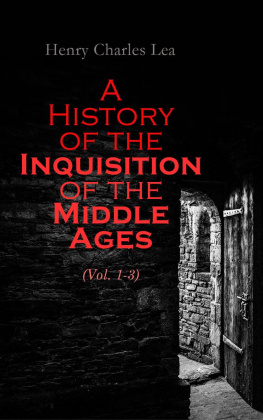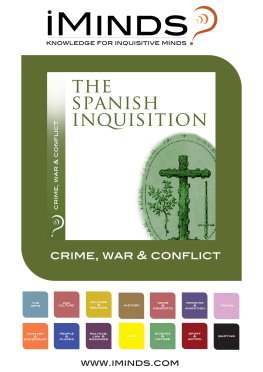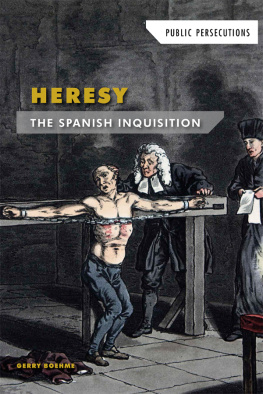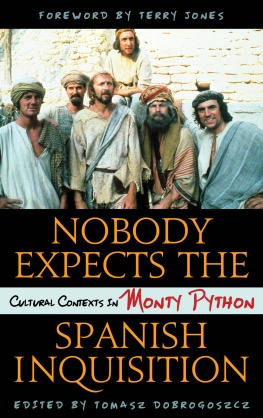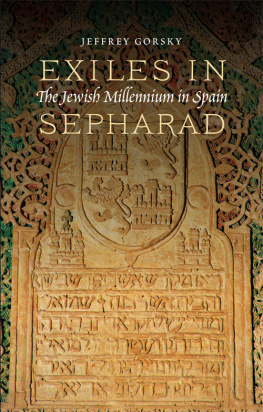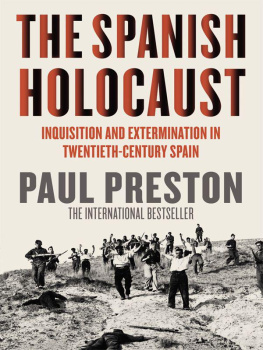THE SPANISH INQUISITION
THE SPANISH INQUISITION
A Historical Revision
FOURTH EDITION
Henry Kamen

Published with assistance from the Mary Cady Tew Memorial Fund.
Fourth edition copyright 2014 by Henry Kamen. All rights reserved.
First edition published 1965 by Weidenfeld & Nicolson as The Spanish Inquisition. Second edition published 1985 by Weidenfeld & Nicolson as Inquisition and Society in Spain. Third edition published 1998 by Yale University Press as The Spanish Inquisition: A Historical Revision. Fourth edition 2014.
This book may not be reproduced, in whole or in part, including illustrations, in any form (beyond that copying permitted by Sections 107 and 108 of the U.S. Copyright Law and except by reviewers for the public press), without written permission from the publishers.
Yale University Press books may be purchased in quantity for educational, business, or promotional use. For information, please e-mail sales.press@yale.edu (U.S. office) or sales@yaleup.co.uk (U.K. office).
Set in Electra and Trajan type by Integrated Publishing Solutions.
Printed in the United States of America.
Library of Congress Cataloging-in-Publication Data
Kamen, Henry.
The Spanish Inquisition / Henry Kamen. Fourth Edition.
pages cm
Includes bibliographical references and index.
ISBN 978-0-300-18051-0 (pbk.)
1. InquisitionSpain. 2. SpainChurch history. I. Title.
BX1735.K312 2014
272'.20946dc23 2013046026
A catalogue record for this book is available from the British Library.
This paper meets the requirements of ANSI/NISO Z39.48-1992 (Permanence of Paper).
10 9 8 7 6 5 4 3 2 1
What power is there like that of this holy tribunal? Non est potestas super terram, quae comparetur ei; it alone governs, disposes, annuls and orders as it wishes, and nobody dares say to it, Cur ista facis?
FRAY TOMS RAMN, OP, BARCELONA, 1619
CONTENTS
page 260
PREFACE
Quite some time ago, I wrote an exploratory study of the Spanish Inquisition that became a best seller in ten languages. Thanks in part to new perspectives opened up since then by scholars, I was able to prepare subsequent editions, the last one sixteen years ago. The present volume follows the same layout of material but is a substantially fresh work that relies inevitably on previous research (both mine and that of others) and in which I arrive at somewhat different conclusions, as the reader will see.
Very many volumes have been written about the Inquisition, among them popular histories, novels and essays, some with a tendency to sensationalism and an emphasis on deaths, tortures, tyranny and fear. These characteristics certainly existed. But how prevalent were they? And were they uniquely Spanish, unmatched by other peoples in other times? Modern scholarship has attempted to look at these questions. The classic work on the Spanish Inquisition is that of the American scholar Henry Charles Lea (19068), available online and still the most reliable history. Like leading European historians of his day, Lea looked for a key to an explanation in laws and institutions. Later scholars adopted other approaches. An organization that survived for over three centuries and exercised power in several continents is clearly amenable to different ways of interpreting its trajectory.
Problems of interpretation arise with the very documents that are the basis of research. Can we trust them? A few scholars have thrown the cat among the pigeons by declaring them to be unreliable. There are also students of literature who avoid historical documents because they prefer a subjective interlinear reading of literary texts. On the other side are those who by contrast put their full confidence in Inquisition sources, trusting in the possibility of writing a truthful study of its activities through the perspective of the inquisitors themselves. Most working historians, like myself, accept these approaches only in part and with many reservations. What cannot be denied, for example, is that the original sources, like all police-type documentation, present problems of tainted evidence. During its lifetime the Holy Office kept its papers secret; now that they are freely available they are ironically being used at times to support the very image that the Holy Office wished for itself: an institution backed solidly by state power, capable of instilling terror in the population, summoning the masses to huge rallies, controlling what people did, believed, read and even thought. It is an image found not only in popular books but even in scholarly ones, and it can seriously impede the advance towards a clearer understanding of the impact of security organizations on the society they attempt to police.
The present account prefers not to see the Inquisition as the only player in the dramas in which it participated. It accordingly tries not only to focus on the tribunal, which had a smaller part in religion and politics than we tend to think, but attempts to place it within the broader perspective of what other entitiesChurch, state and peoplewere doing. At the same time, it modifies the notion of a uniquely Spanish phenomenon, since much that went on in the peninsula was the common experience also of southern Europe and in particular of Italy, whose Inquisition has been very well studied in recent years. Even within the peninsula it is significant that many Spaniards looked on the Inquisition not as theirs but as an alien (that is, Castilian) tribunal.
This book obviously owes a great deal to scholars whose work has deepened our knowledge of the Holy Office. Even our disagreements have helped, by obliging me to look for evidence to support my own approach. Ongoing debates about approaches to and interpretations of the tribunal have been impossible to fit into the body of the text, and I have frequently relegated comments to the endnotes, which contain more archival information and references than previous editions. The quantity of material has obliged me to exclude detailed treatment of the eighteenth and nineteenth centuries, when the Inquisition was virtually inert.
I have tried to arrive at a portrait of the tribunal in its peninsular context more consistent with what we now know, but in doing so I may be depriving readers of the familiar images of terror, flames and tyranny they may prefer to see, and many who prefer moral outrage to dictate their view of the past will assuredly be disappointed. Perhaps that is just as well. A recent writer on the theme in the New Yorker has lamented that historians now study the Inquisition without sufficient imagination, not giving enough emphasis to pain and suffering. The yearning for yet more imaginative fiction is misplaced. Obsessive focus on something terrible called inquisition has often made us conjure up a historical Godzilla that fails to coincide with truth or reality. In fixing all our sights, moreover, on imagined happenings in the past, we run the risk not only of distorting what has been but also of failing to recognize the certainly more powerful inquisitions that still threaten us today. Coercion was no monopoly of Mediterranean culture, nor in our times does it any longer need religion or ideology to drive it. As Cullen Murphy comments in his broad-ranging new book, Gods Jury, an inquisition impulse can quietly take root in the very systems of government and civil society that order our lives.
Lake Oconee, Georgia, 2013
THE SPANISH INQUISITION
1
FAITH AND DOUBT IN THE MEDITERRANEAN
Asked if he believed in God, he said Yes, and asked what it meant to believe in God, he answered that it meant good food, good drink and getting up at ten oclock.
Next page

